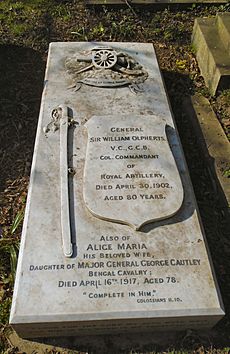William Olpherts facts for kids
Quick facts for kids
William Olpherts
|
|
|---|---|
 |
|
| Born | 8 March 1822 Dartry, County Armagh |
| Died | 30 April 1902 (aged 80) Upper Norwood, London |
| Buried | |
| Allegiance | |
| Service/ |
|
| Rank | General |
| Battles/wars | |
| Awards | |
General Sir William Olpherts (8 March 1822 – 30 April 1902) was a brave officer in the British Indian Army. He was from Ireland and received the Victoria Cross. This is the highest award for bravery a soldier can get when facing the enemy in British and Commonwealth forces.
Contents
Early Life and Military Start
William Olpherts was born on March 8, 1822, in Dartry, near Armagh, Ireland. He went to school at the Royal School Dungannon. In 1837, he joined the East India Company's military school, called Addiscombe.
He became an artillery officer and joined the Bengal Artillery in India in 1839. Artillery uses large guns, like cannons.
Early Battles in India
William Olpherts was sent to Moulmein, Burma, in 1841 to help stop some trouble. Later, he helped put down a rebellion near Saugor in 1842. He was praised for his actions in battle.
He learned local languages and was given command of a field battery. This was a group of mobile cannons. He fought in the Gwalior campaign in 1843 and was again mentioned for his bravery.
He also served in the First Anglo-Sikh War in 1846. He even helped create a new artillery battery using soldiers from the Sikh army. Olpherts then served in different parts of India. In 1851, he was stationed at Peshawur and took part in expeditions against local tribes. For this, he later received a special medal.
Fighting in the Crimean War
In 1854, the Crimean War started. William Olpherts volunteered to serve and went to Kars, a city in Turkey. He traveled through difficult snowy mountains.
He was put in charge of 7,000 Turkish soldiers. His job was to protect against a possible attack from the Russians. Because of this assignment, he was not involved when Kars later surrendered. After the war ended in 1856, he returned to India.
The Indian Mutiny
William Olpherts played a big part in stopping the Indian Mutiny (1857–1859). This was a major rebellion against British rule in India.
He fought with Brigadier James Neill at Benares in 1857. He then joined Havelock's forces during the Relief of Lucknow. This was a very important mission to rescue British people trapped in the city of Lucknow. His actions during this mission were incredibly brave and earned him the Victoria Cross.
His Victoria Cross Action
On September 25, 1857, during the attack on Lucknow, Olpherts showed amazing courage. He rode his horse with the 90th Regiment, which was led by Colonel Campbell. They bravely charged forward and captured two enemy cannons, even though they were under heavy fire.
After capturing the cannons, he rode back through intense gunfire to get horses and equipment. He then successfully moved the captured cannons away. This act of bravery was officially recognized by Major-General Havelock.
More Heroic Acts
Just two days later, Olpherts showed even more courage. When Havelock's main force reached the Residency (where people were trapped), the soldiers at the back were cut off. Olpherts, along with Colonel Robert Napier, went out with a small group. With his calm determination, he brought back the wounded soldiers and the cannons from the rearguard.
Sir James Outram, who was in charge at Lucknow, wrote to Olpherts, saying his bravery was beyond words. Colonel Napier also praised him in his report.
Olpherts continued to serve as an artillery commander during the siege of Lucknow. He was again praised for his bravery when the city was finally captured in March 1858. For his service in the mutiny, he received promotions, the Victoria Cross, and other honors.
Later Campaigns in India
After the mutiny, Olpherts continued his active service for twenty more years. He volunteered for an expedition against the Waziris in 1859–60. His daring style earned him the nickname "Hell-fire Jack." However, he always gave credit to the soldiers under his command.
From 1861 to 1868, he commanded artillery units in different frontier areas. In 1868, he returned home to England. The city and county of Armagh honored him with a special sword.
He returned to India in 1872 and commanded different brigades. He left India in 1875 when he reached the rank of major-general. He was promoted to lieutenant-general in 1877 and general in 1883. In 1888, he became a colonel commandant of the Royal Artillery. He received further high honors in 1886 and 1900.
Retirement and Legacy

General Sir William Olpherts passed away on April 30, 1902, at his home in Upper Norwood, London. He was buried at Richmond Cemetery in Surrey. He had one son and three daughters with his wife, Alice.
His Victoria Cross medal is now on display at the National Army Museum in Chelsea, England.

